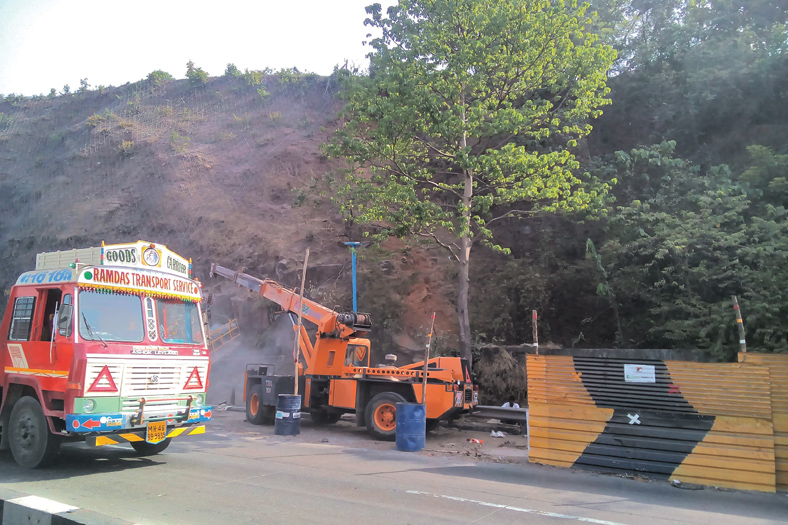Road building equipment segment: stronger and better equipped
As the policies are getting better with the time, road equipment manufacturers are focusing on this sector
India’s roads and bridges infrastructure, valued at $6.9 billion in 2009, is expected to touch $19.2 billion by 2017. Each segment in the road sector has potential to grow more than 20 per cent a year. This means that the industry size to almost double by the end of 2020. No wonder the big or small equipment manufacturers are focusing on this sector.
India and road building equipmentIndia has the second largest road network in the world at 4.7 million km. The industry is likely to witness technologically superior equipment from different manufacturers. The reason for this growth, according to Abhijit Gupta, Managing Director, Case India, is the intention shown by the new government in clearing policy related hurdles, which should translate into tangible demand in the next fiscal. He explains, “The greater transparency in project allotment through e-auctions, flagship Swachh Bharat programme — including river cleaning and more focus on quality roads and highways — is likely to translate into greater industrial demand in the construction equipment sector in near future.”
There is a little concern too as India has 0.66 km road per sq. km of land. “However, only 50 per cent paved road leaves big opportunity for qualitative improvements,” opines Sanjay Wadnerkar, Vice President, LiuGong India. “We are amongst the lowest in terms of 3.8 Km road per 1,000 people.”The road infrastructure will be the result of how aggressively government agencies work and the abilities of contracting companies to execute the same. “If India’s road and bridge infrastructure has to grow, then both ratios should be improved and to be benchmark against the developed countries and we will see the horizon is too big to cut in next 5 years,” says Mr Wadnerkar. “Beyond the policy delays and regulatory blocks, the highway construction awards were very low but the good example can be the Yamuna Expressway or Mumbai-Pune Highway through PPP — worth considering for future planning.”
Mr Wadnerkar also shares his opinion to focus on how we can increase our average road speed from 30-40 Km per hour to 60-70 km per hour by developing multi-lane roads. “China has demonstrated the same,” he explains. “This can support in reducing the fuel bills, freight cost and transit time as added value in economic growth. This is more feasible option.”
Essential road building equipmentThere are three phases in the construction of road and highways: rough grading (or earthmoving), fine grading (which includes sub-grade preparation), and surfacing, which can include gravel, concrete, asphalt, or any combination of the three. The most important equipment in road construction sector are loader backhoes, vibratory compactors, skid steers, motor graders and wheel loaders. Here are few well-known road equipment manufacturers:
Liugong: Liugong is one of the leaders in the design and production of wheel loaders. In 2012, LiuGong held nearly 14.4 per cent of the global market share in wheel loaders. It has a wide range of road equipment supported with earthwork products. The 1.8-5 tonnes loaders and 17 tonnes graders are from its local manufacturing facilities. Liugong is adding the heavy-duty graders soon. The range of compactors, pavers and millers can be offered as one-stop solution to Tier-I and -II contractors. Liugong is closely watching the opportunities in infrastructure development due to its nature of business. “We have successfully supporting the roads and bridges through our equipment used by leading Infra companies,” remarks Mr Wadnerkar. “Liugong is offering a range of wheel loaders, motor graders as ‘Make in India’ products. Multiple capacities of wheel loaders are available for RMC, crushers, cement plant and large material handling in road and bridges value stream. We would like to lead the segments and grow with the opportunities.”
Case: Case offers loader backhoes, vibratory compactors, skid steers, motor graders and wheel loaders. It makes Case a one-stop solution provider to cater to all its customer needs whether urban or rural. It also offers skid steer loaders with a variety of attachments. Broomers and graders are popular attachments in the road construction industry. Case has made progress by introducing the skid steer loaders in the market. The machine is popular as it is capable of working in confined areas.
Mr Gupta says that road building equipment is a potential market, and Case is making continuous efforts in order to consolidate its leadership position and further strengthen its market share through the introduction of new technology and advanced products that enhance the business value of its offering to its customers.
He also shares their approach towards customer satisfaction, saying, “With a mission to increase customers’ profitability through lowest machine downtime, the entire product range has been suitably upgraded with relevant features.”
Caterpillar: Caterpillar is one of the world’s leading manufacturers of construction and mining equipment. It provides the solutions one needs to build a successful construction contracting business.• A full line of industry-leading construction equipment to handle any job• Over 35 types of work tool attachments• Operator training to maximize productivity and avoid costly mistakes• Comprehensive safety materials and programmes to help reduce accidents and control insurance costs.
Volvo: Volvo Construction Equipment is also a respectable name in manufacturing construction machines. With a full product range, manufactured, serviced and supported all over the globe, Volvo has the right machine and the right solution for all jobs. Its list of products includes wheel loaders, mini wheel loaders, backhoe loaders, wheeled excavators, excavators, mini excavators, articulated haulers, scraper haulers, motor graders, milling equipment, pipelayers, demolition equipment, waste handlers, pavers, compactors and skid steers.
FDI or PPPIn the 12th Plan, the government has earmarked about $1 trillion for infrastructure investment, with 40 per cent of the funds to come from the private sector. It is not surprising anymore that the infrastructure growth holds the key to the industry realising its potential in India. “In order to attract such investment, the Indian Government has eased FDI norms for quite a few sectors of infrastructure development. This is likely to spur the demand for the earthmoving and construction equipment, and if the industry’s full potential is realised, the result could be a $16 billion to $21 billion industry by 2020.”
However, the FDI inflow is a matter of concern. FDI inflow to the top five sectors, including construction, has sharply declined by 37.6 per cent to $6.4 billion in 2014 compared to an overall growth in FDI inflows at 6.1 per cent.
Mr Wadnerkar believes that PPP can be better option as benefits will largely remain in local geographies. However, FDI is necessary to bring investments with effective management of funds and timely implementation of projects. The rural and urban road connectivity will help in employment opportunities, business opportunities for aspiring youth in terms of crusher plant. This goes without saying on the governance of such project funds should improve. ____________________________________________The focus should be on how we can increase our average road speed from 30-40 km per hour to 60-70 km per hour by developing multi-lane roads.
Sanjay Wadnerkar, Vice President, LiuGong India.
Cookie Consent
We use cookies to personalize your experience. By continuing to visit this website you agree to our Terms & Conditions, Privacy Policy and Cookie Policy.









